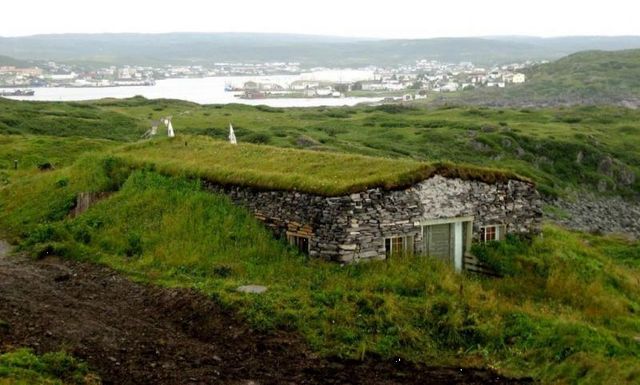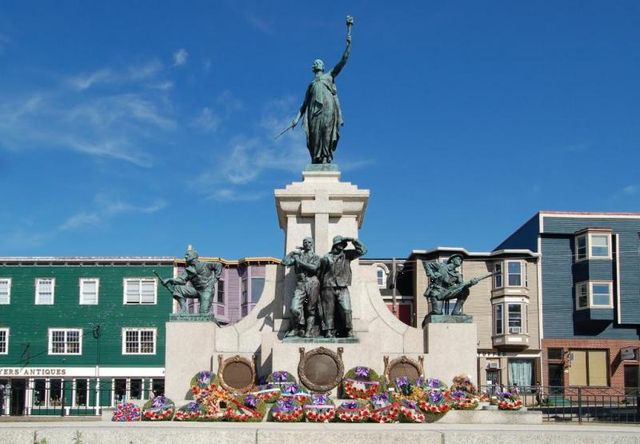August 5, 1583 English navigator Humphrey Gilbert declared Newfoundland owned Britain and founded the first settlement. In honor of this event, we will tell you about the main attractions of the island.
Grand Banks of Newfoundland

More than 400 million years ago, in those places, which is now Newfoundland, there was a clash of two opposing continents. Crumpled under pressure column continental rocks, limestone and sea salts left from the ancient Iapetus Ocean, rocks became the basis of the “New open land” – as translated from the English name of the northern island. Now the distant past of our planet, not just changing its shape, reminiscent of a pronounced river valleys and several offshore shoals – the so-called cans. The biggest of them – more nyufaundlenskaya Bank area 282.500 square kilometers, once reputed to be one of the best fishing areas in the world. Due to the uncontrolled production quantity of herring and cod, before flooding the sea is the kingdom, izryadko decreased, and now fishing, Kojima did not disdain and Soviet anglers, is prohibited.
Attractive places in Newfoundland: Grand Banks of Newfoundland

According to the old saga, warlike Vikings who have visited the coast of Finland, England, settled in Greenland and Iceland, and have visited throughout North America. At the beginning of the second millennium, Leif Eriksson, nicknamed Happy swam to “Vinland” – the land of lakes, where vodilas “unprecedented red fish”, forests full of all kinds of game, and the winters so soft that were suitable for grazing. In the twentieth century, researchers sought to retrace the journey of the Vikings launched a large-scale search of Vinland, having studied the area from Long Island to the Hudson Strait. Searches were successful: in 1960 in Newfoundland were found the remains of ancient pit houses and forges. In 1978, L’Anse aux Meadows, on, the earliest surviving evidence of the arrival of Europeans in the lands of North America, was placed under the protection of UNESCO and turned into a historical park.
Gros Morne National Park in Newfoundland

Retreating glaciers past, drawn thousands of years ago the island of Newfoundland in the cold transparent frame, left behind a wonderful reliefs – the scenic cliffs and the green mountain valleys, waterfalls and fjords, alpine plateau and clean, if a tear lake. One such place is born the forces of nature – it is Gros Morne, famous for its beautiful scenery. Bubbling stream of the highest in eastern North America falls Pissing March breaks down to 350 meters in height, filling the long, 30-kilometer Lake Western Brook fresh deep blue water. 600-meter-high plateau Teybllend created by magma flows millions of years ago, gradually turns into a lifeless desert plateau, surrounded by orange-yellow cliffs. The national park is full of emerald alpine plains, home to black bears and lynx, arctic hares and Canadian caribou, 239 species of birds and even seals island.
National War Memorial, St. John’s

Four times a year at the Royal beach where Sir Humphrey Gilbert in 1583 proclaimed the Newfoundland colony of England, with parades and ceremonies. Center marches designed to perpetuate the memory of soldiers who died during the First World War is the National War Memorial, St. John’s. This impressive monument, opened in 1924 on the initiative of the Newfoundland Regiment preacher father Thomas Nangla, built in a semicircular granite plateau rising above the stairs. Around the central figure of a woman with a torch and sword, symbolizing readiness to serve the island for the benefit of the empire, the statues of the defenders of the state – a fisherman and a woodcutter, a sailor and a soldier. Bronze plaques, lying on both sides of the monument, contain words of gratitude to those who gave their lives for their country during the First and Second World Wars and conflicts in Korea and Afghanistan.
Mount Signal Hill in Newfoundland
In 1901, Guglielmo Marconi received a patent for a wireless communication system, has made a bold experiment. Using a large antenna mounted on Mount Signal Hill, scientist received the first signal transmitted from Cornwall using Morse code. Three dots representing the letter “S”, was the beginning of a new era – a year later between the United Kingdom and its distant colony was adjusted full audio communication. Signal Hill is now the national historic landmark and is under state protection. At its top, where stands the old tower Cabot, built in 1898 for the 400th anniversary of the discovery of the island, is a picturesque trail, popular among tourists. Bypassing the slopes have become a field of bloody battles during the Napoleonic Wars, it leads to an observation platform that offers the best panoramic views of St. John’s and the endless blue of the ocean.
The most attractive places in Newfoundland
No comments:
Post a Comment